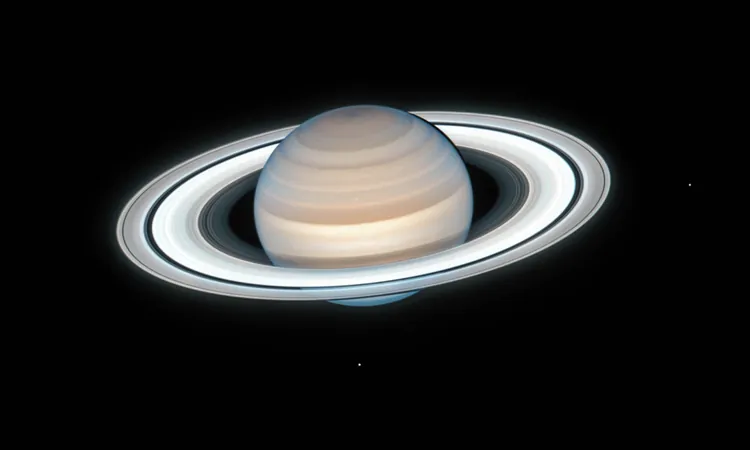
Saturn's Spectacular Rings Set to Disappear for Months – A Cosmic Event You Can't Miss!
2025-01-12
Author: Chun
Saturn, often hailed as the jewel of our solar system, is best known for its stunning rings that have captivated stargazers for centuries. Since the observations made by 17th-century Italian astronomer Galileo Galilei—who famously described Saturn as having "ears" due to his limited viewing technology—our understanding has significantly evolved thanks to modern telescopes and global observatories.
The Magnificence of Saturn's Rings
These iconic rings aren't just a feast for the eyes; they offer critical insights into the cosmic dynamics playing out within our solar system. Researchers are able to delve into the gravitational forces at play, enhancing our knowledge of how celestial bodies interact. Jonah Peter, an astrophysics doctoral student from Harvard-Smithsonian Center for Astrophysics, is currently examining how Saturn's moons influence the intricate environment of the rings, revealing the cosmic dance governed by orbital mechanics.
When Will Saturn's Rings Disappear?
Mark your calendars! On March 23, 2025, celestial events will align, leading to what astronomers call a "ring plane crossing." During this astonishing moment, Saturn's rings will appear to vanish from view as their thin edges turn away from Earth. In this configuration, Saturn will resemble a pale yellow sphere, with only the faintest hint of rings visible through powerful telescopes.
The Science Behind the Rings
Saturn’s rings are structured into sections labeled A, B, C, and several fainter rings, including D, E, F, and G. The enigmatic Cassini Division, an impressive 2,982 miles wide, forms a notable gap between the A and B rings, revealing the complex interactions of gravitational forces that keep this celestial marvel intact.
These rings are not solid but made of a myriad of particles, from tiny dust grains to chunks as large as school buses. The origins of these rings remain a subject of debate; some scientists suggest they may have formed from a moon torn apart by Saturn’s strong gravitational pull, while others believe they are remnants from the planet’s formation over four billion years ago.
The Role of Moons in Ring Structure
Saturn boasts at least 145 moons, some of which serve as "shepherd moons," helping to maintain the structure of the rings by using their gravitational pull to keep ring particles in place and create familiar gaps. Titan, Saturn's largest moon, is particularly intriguing, with researchers eager to explore its nitrogen-rich atmosphere and possibilities of hosting life.
Expedition to Titan: Discoveries Await!
NASA's upcoming Dragonfly mission aims to explore Titan by sending an innovative exploratory craft to this captivating moon. Scientists are excited to investigate its unique terrains and the potential existence of life within its hydrocarbon lakes, as well as phenomena like bright auroras at its poles.
Enceladus: The Hidden Gem of Saturn
Another moon, Enceladus, has captured the attentions of astrobiologists due to its icy plumes that hint at possible life-sustaining conditions beneath its frozen surface. The Cassini mission unearthed water vapor venting into space, sparking hopes that this distant moon may hold the key to finding life beyond Earth.
Embrace the Cosmic Wonder
Galileo's initial observations serve as a reminder of how far we’ve come in our exploration of the universe. As we prepare for Saturn's rings to take a brief hiatus in 2025, we can appreciate the cyclical nature of the cosmos—sticking to a routine that promises wonder and discovery awaits every time we gaze skyward.
Although the rings will fade from view, rest assured they will return, reminding us of the ever-changing dynamics of our fascinating solar system. This event offers a unique opportunity to reflect on our position in the cosmos and the secrets still hidden among the stars. Stay tuned for updates and catch this rare celestial performance while you can!
Don’t Miss Out!
For more exciting news from the universe, subscribe to our newsletter and stay informed about the latest developments in space exploration!



 Brasil (PT)
Brasil (PT)
 Canada (EN)
Canada (EN)
 Chile (ES)
Chile (ES)
 Česko (CS)
Česko (CS)
 대한민국 (KO)
대한민국 (KO)
 España (ES)
España (ES)
 France (FR)
France (FR)
 Hong Kong (EN)
Hong Kong (EN)
 Italia (IT)
Italia (IT)
 日本 (JA)
日本 (JA)
 Magyarország (HU)
Magyarország (HU)
 Norge (NO)
Norge (NO)
 Polska (PL)
Polska (PL)
 Schweiz (DE)
Schweiz (DE)
 Singapore (EN)
Singapore (EN)
 Sverige (SV)
Sverige (SV)
 Suomi (FI)
Suomi (FI)
 Türkiye (TR)
Türkiye (TR)
 الإمارات العربية المتحدة (AR)
الإمارات العربية المتحدة (AR)